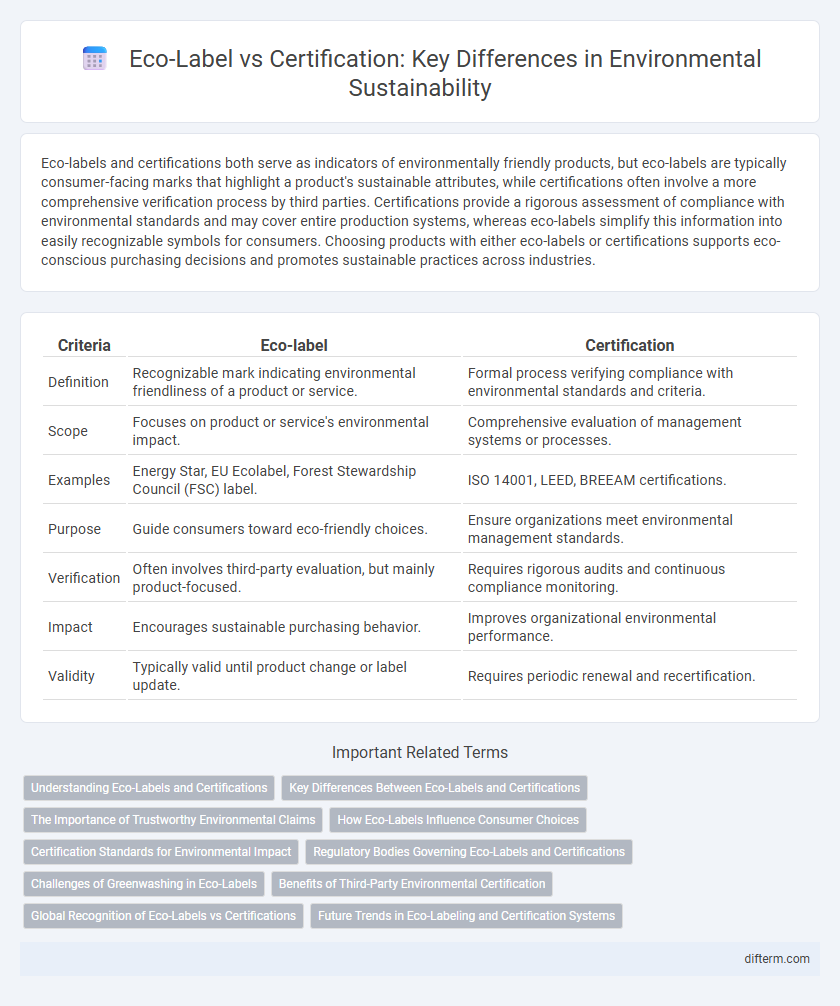Eco-labels and certifications both serve as indicators of environmentally friendly products, but eco-labels are typically consumer-facing marks that highlight a product's sustainable attributes, while certifications often involve a more comprehensive verification process by third parties. Certifications provide a rigorous assessment of compliance with environmental standards and may cover entire production systems, whereas eco-labels simplify this information into easily recognizable symbols for consumers. Choosing products with either eco-labels or certifications supports eco-conscious purchasing decisions and promotes sustainable practices across industries.
Table of Comparison
| Criteria | Eco-label | Certification |
|---|---|---|
| Definition | Recognizable mark indicating environmental friendliness of a product or service. | Formal process verifying compliance with environmental standards and criteria. |
| Scope | Focuses on product or service's environmental impact. | Comprehensive evaluation of management systems or processes. |
| Examples | Energy Star, EU Ecolabel, Forest Stewardship Council (FSC) label. | ISO 14001, LEED, BREEAM certifications. |
| Purpose | Guide consumers toward eco-friendly choices. | Ensure organizations meet environmental management standards. |
| Verification | Often involves third-party evaluation, but mainly product-focused. | Requires rigorous audits and continuous compliance monitoring. |
| Impact | Encourages sustainable purchasing behavior. | Improves organizational environmental performance. |
| Validity | Typically valid until product change or label update. | Requires periodic renewal and recertification. |
Understanding Eco-Labels and Certifications
Eco-labels and certifications serve as official indicators of a product's environmental impact, providing consumers with trustworthy information on sustainability. Eco-labels focus on communicating a product's adherence to specific environmental standards, such as organic farming or energy efficiency, while certifications involve rigorous third-party evaluations that validate compliance with established eco-friendly criteria. Both tools play a crucial role in promoting transparent environmental responsibility and encouraging sustainable consumer choices.
Key Differences Between Eco-Labels and Certifications
Eco-labels focus on providing consumers with easily recognizable symbols indicating that a product meets specific environmental standards, emphasizing transparency and informed purchasing decisions. Certifications involve a rigorous verification process conducted by third-party organizations to ensure compliance with established sustainability criteria across production, resource management, and social responsibility. The key differences lie in eco-labels serving as marketing tools that communicate environmental benefits directly to consumers, while certifications provide in-depth validation and accountability through standardized assessments and audits.
The Importance of Trustworthy Environmental Claims
Trustworthy environmental claims hinge on credible eco-labels and certifications that verify sustainable practices through rigorous third-party assessments. Eco-labels, such as ENERGY STAR or Fair Trade, provide transparent criteria ensuring products meet specific environmental standards, reducing greenwashing risks. Certifications validate corporate commitment to sustainability, driving consumer confidence and promoting responsible consumption.
How Eco-Labels Influence Consumer Choices
Eco-labels provide consumers with easily recognizable symbols indicating a product's environmental impact, promoting sustainable purchasing decisions by highlighting adherence to green standards. These labels often emphasize aspects such as reduced carbon footprint, use of renewable resources, and ethical sourcing, directly affecting buyer preference toward eco-friendly products. Studies show that clear and trustworthy eco-labels enhance consumer confidence, driving market demand for certified goods and fostering environmental responsibility.
Certification Standards for Environmental Impact
Certification standards for environmental impact establish rigorous criteria to evaluate a product's sustainability throughout its lifecycle. Unlike eco-labels, which mainly serve as visible consumer guides, certifications involve comprehensive audits and compliance verification by accredited bodies, ensuring transparency and accountability. These standards prioritize measurable reductions in carbon emissions, resource consumption, and pollution, fostering genuine ecological improvements in production and supply chains.
Regulatory Bodies Governing Eco-Labels and Certifications
Regulatory bodies governing eco-labels and certifications establish stringent criteria to ensure environmental claims are credible and verifiable. Organizations such as the International Organization for Standardization (ISO) and the Global Ecolabelling Network (GEN) set standardized guidelines to maintain transparency and consistent assessment processes. Compliance with these regulations enhances consumer trust and promotes sustainable practices across industries.
Challenges of Greenwashing in Eco-Labels
Eco-labels often face challenges of greenwashing, where misleading claims obscure the true environmental impact of products, undermining consumer trust and market effectiveness. Certification processes vary in rigor, making it difficult to distinguish genuinely sustainable products from those with superficial or false eco-friendly claims. Strengthening transparency, standardization, and third-party verification can mitigate greenwashing risks in eco-label initiatives.
Benefits of Third-Party Environmental Certification
Third-party environmental certification ensures impartial verification of sustainable practices, boosting consumer trust and brand credibility. Certified products often meet rigorous standards, leading to reduced environmental impact and promoting responsible resource use. This independent validation supports regulatory compliance and enhances market access for eco-conscious businesses.
Global Recognition of Eco-Labels vs Certifications
Eco-labels often achieve broader global recognition due to standardized environmental criteria endorsed by international organizations like the Global Ecolabelling Network (GEN). Certifications, while frequently specialized and industry-specific, may vary widely in recognition depending on regional regulations and sector standards. The universal acceptance of eco-labels facilitates consumer trust and facilitates cross-border trade, contrasting with the localized scope typical of many certifications.
Future Trends in Eco-Labeling and Certification Systems
Future trends in eco-labeling and certification systems emphasize increased transparency through blockchain technology and AI-driven data analysis to ensure authenticity and traceability. Innovative eco-labels are evolving to incorporate circular economy principles, promoting resource efficiency and waste reduction across supply chains. Global harmonization of standards is expected to facilitate consumer trust and streamline compliance for manufacturers in diverse markets.
eco-label vs certification Infographic

 difterm.com
difterm.com